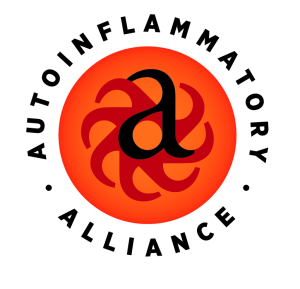 The Autoinflammatory Alliance is a 501 (c)(3) non-profit public charity dedicated to promoting awareness, proper diagnosis and treatment, and improved care for people with autoinflammatory diseases.
The Autoinflammatory Alliance is a 501 (c)(3) non-profit public charity dedicated to promoting awareness, proper diagnosis and treatment, and improved care for people with autoinflammatory diseases.
We got our start in 2006, under the name The NOMID Alliance, but we changed our name officially in 2014 to the Autoinflammatory Alliance. Our mission has been essentially the same since the very beginning, but with this name change, we decided to simplify the statement a bit.
In the beginning, our mission was “to promote awareness, care, and treatment for patients and their families with Cryopyrin-Associated Periodic Syndromes (CAPS) or other autoinflammatory diseases.” We have had content about all these diseases on our website since the start, and have been a resource for patients of all ages, from all around the US and the world that are dealing with these diseases. Also, we help hundreds of undiagnosed people every year that come to us, looking for guidance and direction on where to go to get help for their symptoms.
Why change the name? We have always been an “alliance” for all autoinflammatory diseases, started by a group of families dealing with CAPS (mostly NOMID), but the new name better reflects our purpose to all.
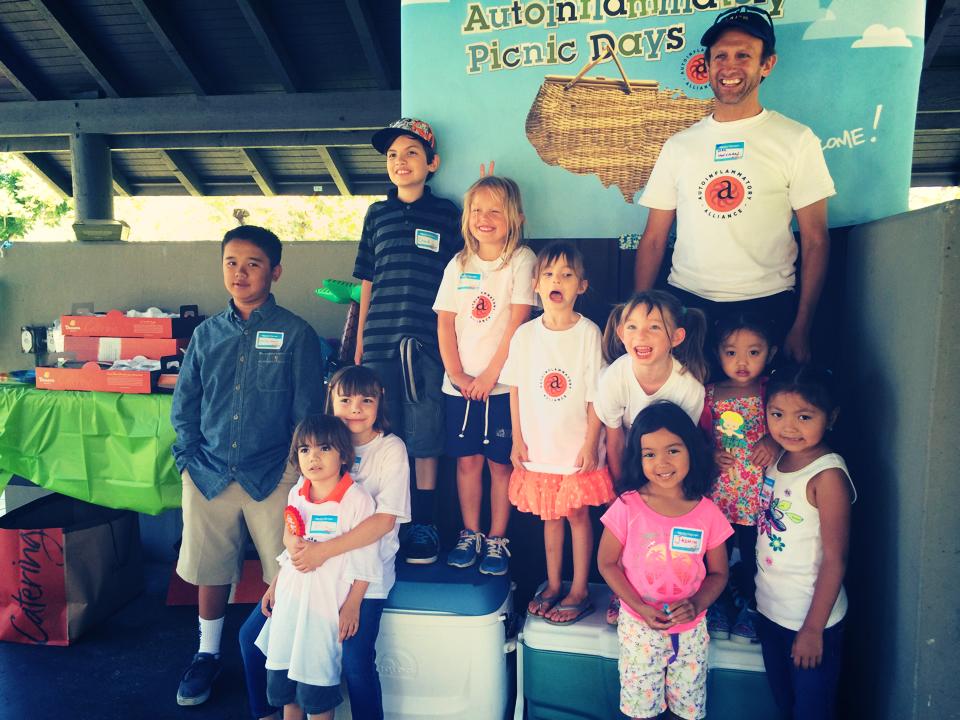
Patient picnics supported by the Autoinflammatory Alliance have allowed people with these rare disease to meet others in person.
In the Beginning…
Outside of the wonderful American Behçets Disease Association (ABDA) there were no other non-profit organizations in the United States (and next to none globally) for systemic autoinflammatory diseases before we formed ours in 2006. At that time, it was not known that Behçets was an autoinflammatory disease. But there were a few very active, helpful online patient communities. These were a lifeline to patients and their families and often the only resource written for patients at that time. Unfortunately, most of these are now defunct, but they were a light to many, and helped us greatly in the early 21st century. These communities were a beacon of hope, support and up to date information in a sea of uncertainty, and confusion for many patients.
We have to say thanks to the dedicated leaders of these first online support groups, especially to Kate Barton (nomidsyndrome.com and the nomidsyndrome Yahoo group), Brad Miles (Cold Urticaria Info Island site and online community), PapaBen (FMFcommunity.org), the Yahoo PFAPA group started by Fran Bulone, and to many others in the US, and worldwide.
Access to Patient Communities is Essential
When these groups started to disappear, or become inactive a few years ago, we decided to form (and moderate) two very active, private patient communities on Facebook, one for CAPS and one for all autoinflammatory diseases and moderate the CAPS and TRAPS communities on RareConnect.org. (There are also groups for FMF and Behçets on RareConnect too that are moderated by orgs dedicated to those diseases.)
From These First Connections, a Non-profit was Born
The NOMID Alliance was formed by a group of motivated patients and parents of children with various forms of cryopyrin-associated periodic syndromes (CAPS) along with input from patients with various other autoinflammatory diseases. We came together after each of us struggled for years (in some cases decades), to find a diagnosis, treatment or the right care for these diseases. Our challenges made us realize that something needed to be done so others would not have to suffer so long. Most of us met through the online communities, and later in person at the National Institutes of Health (NIH).
To finally meet another patient and their family facing these diseases in person was a life-changing moment for everyone. It was a feeling in the core of your body and an instant connection that is hard to explain. Going through life, never having anyone in your community or family with these diseases is hard, because few people really understand, or even want to try to comprehend how much these diseases affect every facet of a patient’s and their family’s lives. Often, patients go through life with a lot of judgments, misconceptions, and improper assumptions by others about their symptoms which can lead to very painful emotional wounds, on top of their intense, constant physical pain from these diseases.
Hearing the other patient’s stories in person, seeing how these diseases had affected the older children and patients for years, and learning the consequences of misdiagnosis and improper medical treatments and procedures was a call to action for our patient community.
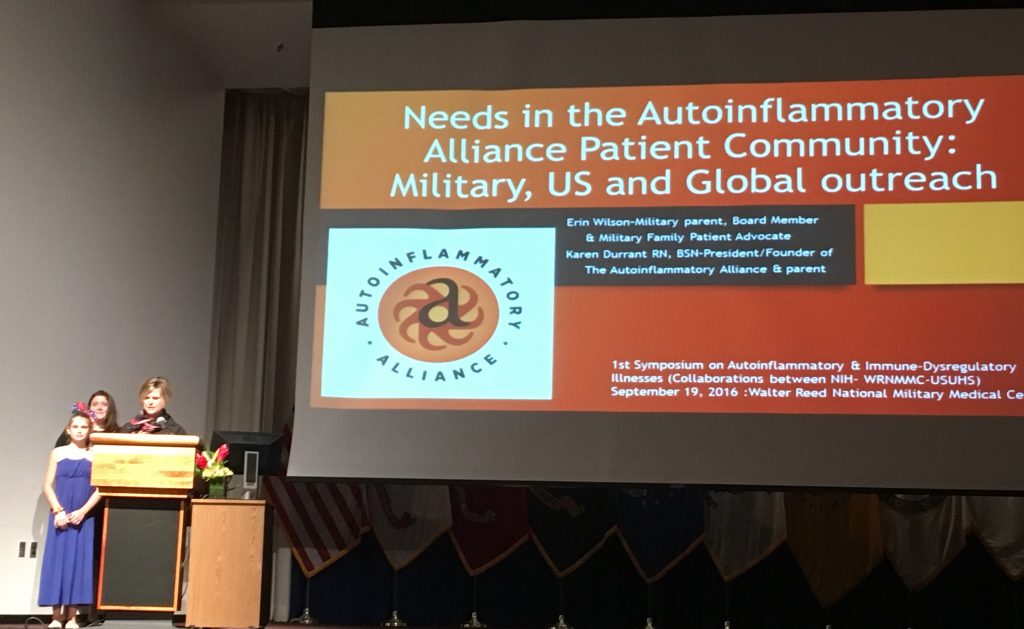
Autoinflammatory Alliance President Karen Durrant and board members regularly attend and even present at rheumatology and autoinflammatory conferences. Here Karen Durrant and board member Erin Wilson speak at the 2016 Autoinflammation & Immune-dysregulation Symposium at Walter Reed National Military Medical Center.
Making a Difference
At first, families tried to contact various news outlets and talk show hosts to try to increase awareness for these diseases, but the reply was that they only wanted to communicate with a non-profit organization. So, a few of us bravely decided that it was about time to get one going, without any prior experience, but a loads of motivation and compassion for the cause!
Luckily, there were some helpful online resources that we found from NORD and the Genetic Alliance on how to start a non-profit for rare diseases, plus some excellent guides from Nolo and a straightforward, flat fee system to file the proper forms for the state and IRS through LegalZoom.
I cannot imagine how hard this would have been without these easy-to-use resources, or the internet. In fact, without the internet and the online patient communities, I am not sure how many of us would have ever found the right diagnosis, another patient with similar issues, or the right clinical trials and treatments that could help these diseases. Still, there was very little information online written for the general public about these diseases, and without knowing what to even be searching for, it was next to impossible to find anything unless you already had a diagnosis.
In 2006, it was exceptional to hear of any child diagnosed with CAPS, especially NOMID, even in the preschool years. This was also the case for a lot of patients with other autoinflammatory diseases. Most were not properly diagnosed until much later. Some were correctly identified as having one of these diseases during school age or adolescence, but many were not diagnosed until they were well into adulthood, even at middle age, or older. A number of people with some forms of CAPS, FMF, or TRAPS often had affected family members for generations who suffered through life undiagnosed.
It seemed that everyone we met with these diseases had endured years of misery. They had been through all sorts of misdiagnoses and ineffective, or even dangerous incorrect treatments (there were a few that were administered chemotherapy, and one patient that had endured chemotherapy, plus a stem cell transplant while misdiagnosed). It is a miracle that they survived, but sadly none of these risky treatments helped them at all.
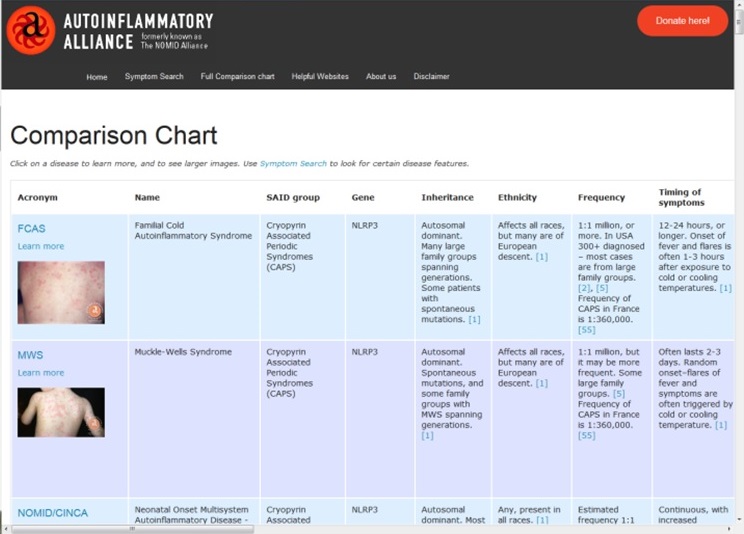
The Systemic Autoinflammatory Diseases Comparison Chart and online database produced by the Autoinflammatory Alliance, with contributions from experts around the world, is now a diagnostic tool that doctors around the world use. This has dramatically increased awareness about all periodic fever syndromes and led to faster diagnosis and correct treatment for many patients.
Increasing Awareness
We all knew that earlier and accurate diagnosis and access to helpful medications and expert doctors could make a huge difference in the quality of life and health of patients. The challenge was finding ways to get this to happen for more people.
So, one of our first tasks was to get an informative website about these diseases online and later printed materials to educate patients, medical professionals, and others about these diseases.
We have made a point of having all of our materials online and accessible for download, or in print at no cost, but we gladly accept (and greatly need) donations to support our efforts. The only way that we can do this is thanks to our volunteers and generous donors– including: fundraisers by friends and family and helpful and significant grants and/or donated services from various companies. These supporters are our heros and we cannot thank them enough.
We started with a guidebook on CAPS, per the request of a number of doctors. Eight years ago it was not widely known that three diseases that were originally considered separate, unrelated conditions were later discovered to all be forms of CAPS. The gene that causes CAPS was discovered in 2001, and then found to also be the cause of NOMID in 2002, so this was a recent finding at that time. A few of the other autoinflammatory diseases were discovered right before the start of the 21st century, so much work on awareness was needed.
Even if doctors knew of the recent genetic findings linking familal cold autoinflammatory syndrome (FCAS), Muckle-Wells syndrome (MWS) and neonatal-onset multisystem inflammatory disease (NOMID) under the category of cryopyrin-associated periodic syndromes (CAPS), they were not aware that there was a lot of overlap between the three diseases, or of the variable degree of severity within CAPS. Patients were often not being diagnosed properly, because of the misconception that one needed to have all the symptoms of one of the forms of CAPS to be diagnosed, but there is a lot of overlap in symptoms between the three forms of CAPS in many patients. This leads to a delay in accurate diagnosis and treatment. I had personally experienced this with my own child in our own struggle to get a diagnosis, as had many other families.
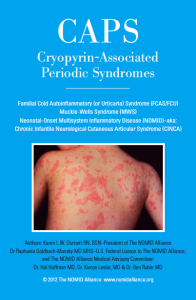 Access to Informative Materials Changes Lives
Access to Informative Materials Changes Lives
The impact of our materials has been huge since our first printed guidebook on CAPS, with the small comparative chart of autoinflammatory diseases was released in 2008. We released a newer version in 2012 in English and in Spanish, along with an updated website. These materials have been distributed across the U.S. and the world helping to increase awareness and at least get more medical professionals to consider these diseases when presented with these sorts of symptoms.
We have had a number of large family groups of patients that had symptoms of CAPS for generations find our materials online and share it with their doctors, which led to their diagnosis and initiation of targeted medications to help control their disease and symptoms.
In addition, many patients with other autoinflammatory diseases have used the chart and information online to start a discussion with their doctors about their symptoms, which has led to a diagnosis, and ultimately, helpful medications for their disease.
Although the guidebook was about CAPS, the most useful part of the book was the center spread that had a comparative chart of the known hereditary periodic fever syndromes. This featured the three forms of CAPS, but also Familial Mediterranean fever (FMF), TNR-receptor associated periodic fever syndrome (TRAPS), and Hyperimmunoglobulinemia D (HIDS). This first chart, in the books and on it’s own as a download, became a leading resource about these diseases and a tool to aid in analyzing a patient’s symptoms. we have since expanded the chart to a more comprehensive version.
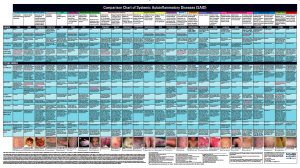 In 2013, we finally released the first comprehensive comparative chart of autoinflammatory diseases and distributed copies to doctors from around the world at the 7th Congress of ISSAID, International Society of Systemic Auto-Inflammatory Diseases where it was part of the poster sessions presentation and thousands more of the most recent version of the chart at the 2013 American College of Rheumatology Annual Meeting. In April 2014, we will be distributing these charts to pediatric rheumatologists from around the U.S. and the world at the ACR Pediatric Rheumatology Symposium (PRYSM) so we can continue to get more awareness about these diseases to doctors and because we have also been flooded with requests for copies by mail.
In 2013, we finally released the first comprehensive comparative chart of autoinflammatory diseases and distributed copies to doctors from around the world at the 7th Congress of ISSAID, International Society of Systemic Auto-Inflammatory Diseases where it was part of the poster sessions presentation and thousands more of the most recent version of the chart at the 2013 American College of Rheumatology Annual Meeting. In April 2014, we will be distributing these charts to pediatric rheumatologists from around the U.S. and the world at the ACR Pediatric Rheumatology Symposium (PRYSM) so we can continue to get more awareness about these diseases to doctors and because we have also been flooded with requests for copies by mail.
The best news is that within weeks of the release of this chart at the ACR, we were getting numerous emails from doctors from all around the world about patients that they were diagnosing with these diseases. We heard from a number of doctors who were using this as a resource to study for their boards or care for their patients.
Our goal is to get more doctors aware of, and to consider autoinflammatory diseases whenever they are presented with patients that have recurrent fevers, rashes, and other symptoms that come with the flares on a regular basis who are not showing signs of infection. Although these will always be rare diseases, they may very well be under-diagnosed, so they could be more prevalent than expected.
You can visit our current website to read more about these diseases, our organization, and view or download some of our materials or request copies in print.
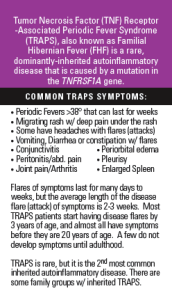 Our other major efforts of the Autoinflammatory Alliance are to inform and empower our patient community with accurate current information and helpful resources that can aid them in getting better care and treatment for their disease. The website has done this, and our online patient communities, but this blog is our newest initiative to get the topics that interest our community the most more attention.
Our other major efforts of the Autoinflammatory Alliance are to inform and empower our patient community with accurate current information and helpful resources that can aid them in getting better care and treatment for their disease. The website has done this, and our online patient communities, but this blog is our newest initiative to get the topics that interest our community the most more attention.
We have found that patients get quite emotional when they can print and share resources about their disease to family, friends, teachers, and to medical professionals. They find that it validates that what they are dealing with is real, significant, and worth caring about. Even our small business card-sized informative cards about a number of these diseases has had a great impact for patients.
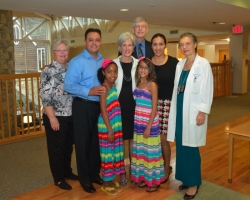
Autoinflammatory Alliance board members also advocate on national and international rare disease issues. Here board member Dorelia Rivera met with top U.S. health officials, U.S. Secretary of Health and Human Services Kathleen Sebelius, Dr. Francis Collins the Director of the National Institutes of Health (NIH), Ms Kathy Russell the CEO of the Children’s Inn at the NIH, and Dr. Raphaela Goldbach-Mansky, who is an expert on autoinflammatory diseases and U.S. Federal Liaison to The Autoinflammatory Alliance.
Impact
The good news is that today, the proper diagnosis of patients with CAPS, especially moderate to severe NOMID is often made in early infancy, largely due to awareness efforts of our organization online, in print, and at medical conferences, in addition to the incredible outreach and presentations at medical conferences by medical experts on these diseases (which includes many of our medical advisers).
Prior to targeted medications to treat CAPS, 20% of the patients with the NOMID form died before adulthood. Now, it is thankfully a very uncommon, to rare, for a patient to die from NOMID as a child if they have had early access to the proper medications and treatment for their disease. We are trying to increase awareness for all autoinflammatory diseases so more patients can have a chance at a healthier future.
We hope that our expanded educational materials, website and this blog will help even more patients with all autoinflammatory diseases to have earlier diagnosis and treatment. Our efforts had to start somewhere, but they have grown to help even more people.
The Autoinflammatory Alliance is a 501(c)(3) non-profit organization dedicated to helping those with autoinflammatory diseases.
Donate now to help with awareness, education, and research for these rare diseases.
![]()

